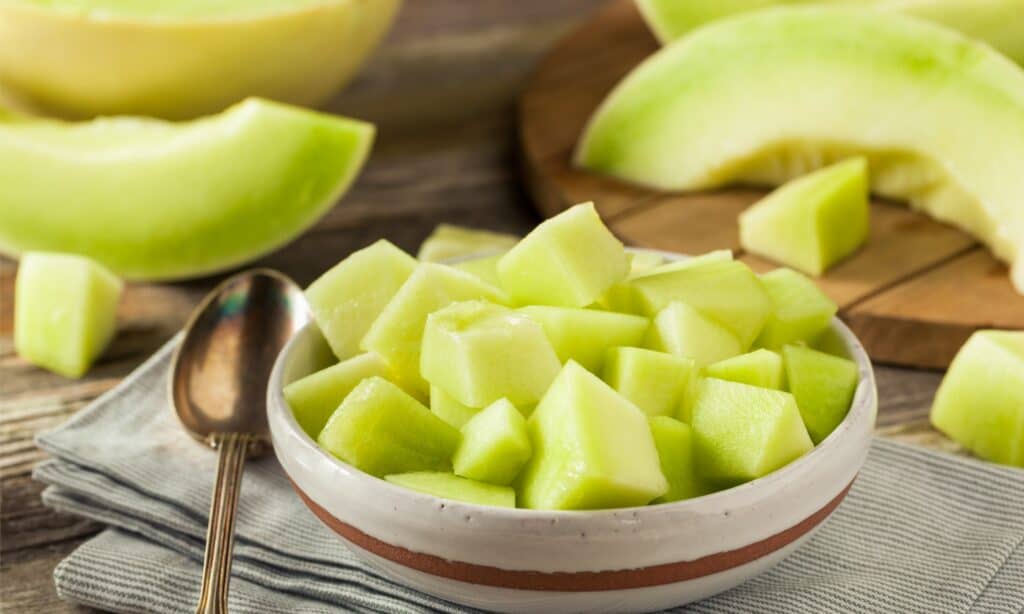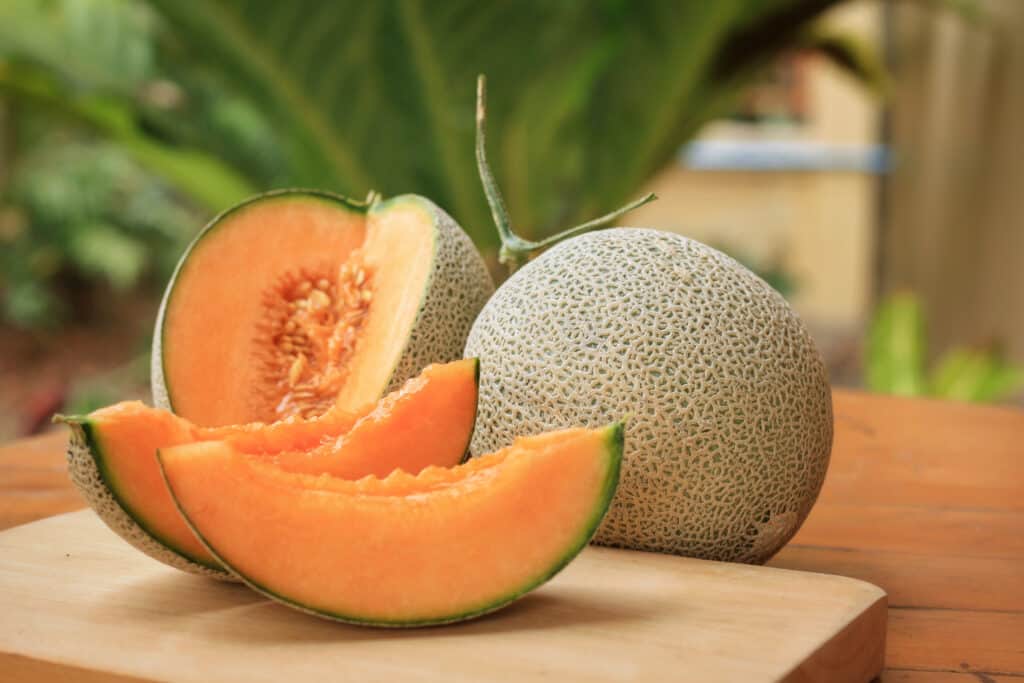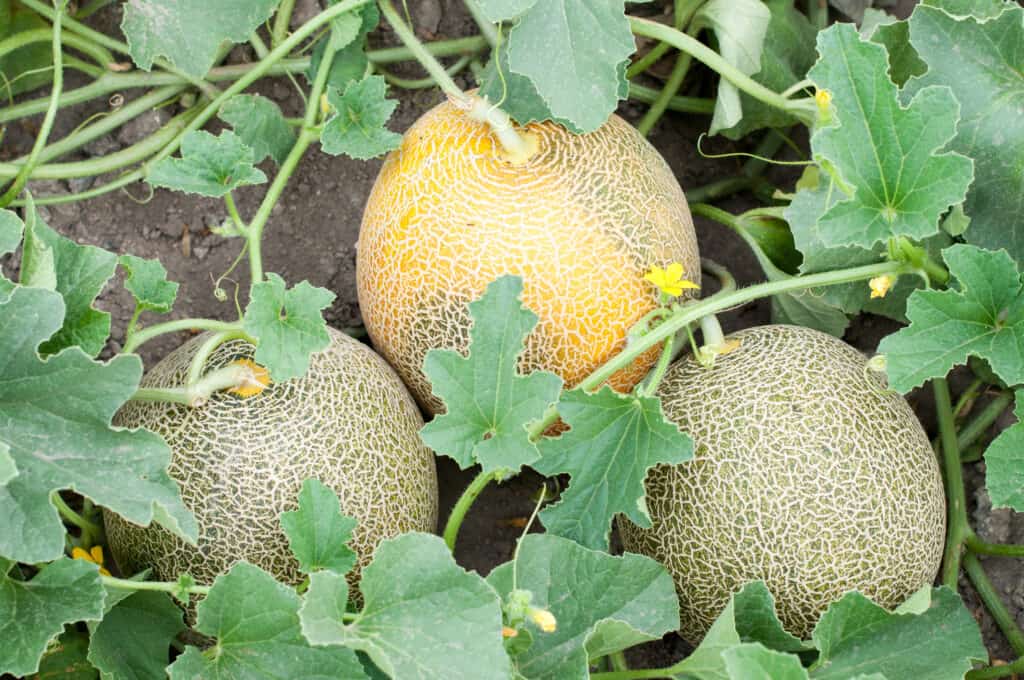Hami Melon vs. Cantaloupe: Full Comparison
While they look very different to some people, hami melons and cantaloupes are similar. Both have the signature orange flesh that we associate with cantaloupes, but hami melons a smoother, greener protective skin. Keep reading to learn everything you need to know about telling these two melons apart.
Hami Melon vs. Cantaloupe: What Are the Differences?
Hami Melons
The critical differences between Hami Melons and cantaloupe include their origin, taste, appearance, and cultivation. Hami Melons are indigenous to the Xingjiang region of China. Hami melons are typically oblong in shape and have orange to yellow flesh, with green streaks running throughout the flesh when it’s healthy and ripe. But since there are over 180 different types of hami melon, don’t be surprised if you see these melons with different colors or shapes! Hami Melons are sometimes referred to as Chinese hami melons or snow melons.
Cantaloupes
It’s not totally clear where the first cantaloupes were grown. They’ve been growing in Africa and Europe for most of written history, but the story of their origins has been lost to time. The plants we now refer to as cantaloupes are similar to melons from the Nile River Valley. It has been hypothesized that these plants may have originated in the Middle East or India and were imported delicacies before they were grown in the Nile River Valley.
Cantaloupes were first introduced to Europe in the 15th century; in fact, the name we give them today, cantaloupe, is a reference to the Cantalupo region of Italy, where these melons were widely grown in the 1700s. The sweetness of the fruit made them a popular delicacy. However, American and European Cantaloupes are different fruits. The American Cantaloupe is often referred to as the muskmelon. However, muskmelon refers to several types of melons, including honeydew and casaba.

The American Cantaloupe is often referred to as the muskmelon. However, muskmelon refers to several types of melons, including honeydew (pictured).
©iStock.com/bhofack2
Appearance
Hami Melons
Hami Melons can have different appearances based on the type of melon being grown. Colors range from yellow to white, and a ripe Hami Melon may have some green left on it, but other varieties shouldn’t be eaten while they’re still green.

Hami melons tend to be oblong.
©iStock.com/jiangjunyan
Cantaloupes
US Cantaloupes are round, unlike Hami Melons, which tend to be oblong. Because the skin looks very similar to the skin of a Hami Melon, it makes sense that these two melons are often mistaken for one another at first glance!

Unlike hami melons, which tend to be oblong, US Cantaloupes are round.
©Kotcha K/Shutterstock.com
Flavor
Hami Melons
Popular opinion has it that hami melon tastes crisper and sweeter than the average cantaloupe. Still, their taste profiles are very similar, though some hami melons may taste more or less intense, and unripe hami melons may have no taste at all!
Cantaloupes
Cantaloupes have a delicate, floral flavor and scent. Unlike the hami melon, the flavor of cantaloupe tends to be a little more subtle and less sweet. However, just like hami melons, an unripe cantaloupe may be crunchy and have no flavor whatsoever!
Cultivation
Hami Melons
Cultivating hami melons is similar to growing cantaloupes. Growing on sprawling vines, they require a lot of space to propagate.
Hami melons need warm soil to propagate. Therefore, many nurseries recommend soil-warming mulches, hot caps, or low tunnel row covers to extend their growing season. These measures can also protect your crops from freezing in early fall when frosts become a risk.
Typically you can directly seed or transplant your hami melon plants in mid-spring, sometimes earlier in the Southern United States. Hami melons do best in warm, sunny areas with well-drained soil. Planting hami melon seeds or bedding plants in the yard’s sunniest part will yield the greatest. They are tropical plants that can handle as much sunshine as they can get!
It is possible to tell when your hami melon is ripe by its scent. A ripe hami melon will smell slightly sweet, conjuring its sweet, sometimes floral taste. However, the best way to determine whether or not your hami melon is appropriately ripe is to look at its stem.
When the hami melon becomes ripe, the area where the stem attaches to the fruit will begin to crack, and the stem will start to look withered. When the melon is ripe and ready to eat, it should break off from the vine with a gentle twist. If the melon doesn’t come off the vine easily, give it a few more days before trying to pick it up again.
Cantaloupes
Cantaloupes will tolerate slightly cooler soil than hami melons and can, therefore, be cultivated at a somewhat lower temperature. They do best when they’re given lots of sun and warmth. They also grow on meandering vines that need a lot of space to propagate. Cantaloupe seeds should be planted at least 32–35 inches apart to allow the vines to sprawl out over the ground without crowding.
You can tell a cantaloupe is ripe by its smell. Cantaloupe should smell lightly sweet when it’s ripe and ready to pick. But like hami melons, the easiest way to be certain that your cantaloupe is ready to be picked is to look at the stem: the area around the stem will start to crack, and the stem will begin to wither when the fruit is ready to be picked. It’s essential to remember cantaloupes — a group to which hami melons belong — need to be propagated in warm climates and don’t deal with chills well.

Cantaloupes and hami melons grow on meandering vines that need a lot of space to propagate.
©iStock.com/tchara
How to Eat Hami Melons
Hami melons are a sweet fruit best eaten in a fruit salad or as a dessert with some ice cream. You can’t eat hami melon seeds, but you can dry them to save for future planting!
How to Eat Cantaloupe
Cantaloupes are very similar to hami melons the table, as hami melons are a type of cantaloupe, after all! However, there is one notable difference between these two fruits when it comes to eating them: cantaloupe seeds are edible and make an excellent snack for cantaloupe lovers. Be certain to wash your cantaloupe before cutting it. Cantaloupes are a common vector for Salmonella. Not thoroughly washing your cantaloupe before cutting it could put you at risk of becoming ill.
Hami melons are a wonderful fruit, similar to cantaloupe, though they are oblong, whereas cantaloupes are round. Cultivated for centuries, both continue to be a welcome addition to any garden or fruit salad.
The photo featured at the top of this post is © iStock.com/agcuesta
Sources
- Cantaloupe Fact Sheet, Available here: https://www.clevelandmetroschools.org/cms/lib05/OH01915844/Centricity/Domain/91/FRUIT-%20CANTELOPE.pdf
- UMN Extension, Available here: https://extension.umn.edu/fruit/growing-melons-home-garden#how-to-extend-the-growing-season-before-planting-1139162
- Whole Foods Market, Available here: https://www.wholefoodsmarket.com/tips-and-ideas/food-guides/melons
- Wikipedia, Available here: https://en.wikipedia.org/wiki/Hami_melon
- Wikipedia, Available here: https://en.wikipedia.org/wiki/Cantaloupe
Thank you for reading! Have some feedback for us? Contact the AZ Animals editorial team.






